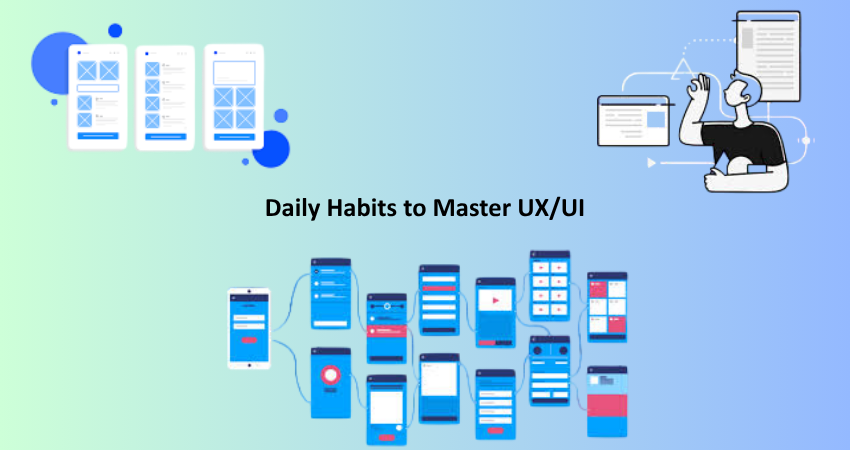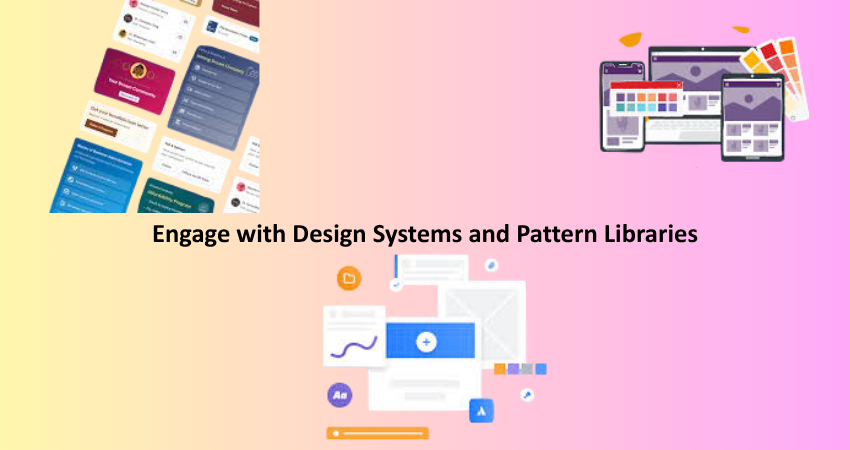
Introduction
UX, or the user experience, and UI, the user interface, are among the disciplines needing time to master. Either would involve a deep understanding of the user, consistent skills refinement, and a steadfast commitment to developing the process of reasoning and execution. Many potential designers may feel overwhelmed at this stage, wondering where to start or how to develop further. The key lies not in grand statements but in the little mindful things done consistently and deliberately each day. Developing good habits around UX/UI allows scattered learning to coalesce into steady progress, providing the platform for latter-day mastery.
Thus, this article sets forth the most impactful daily habits that any designer is likely to adopt in order that they may efficiently yet sustainably develop their UX/UI skills. Daily goal-setting, micro-interaction practices, design system-building, and constructive feedback collection-these routines sharpen your eye, deepen your empathy, and fine-tune your creative thinking. Whether just starting your career or already in the field, implementing them will keep you on track, challenge you, and, in the long run, hone your ability to create better user experiences.
Start the Day with UX Reflection and Goal Setting
Reviewing Yesterday’s Work with a Critical Eye
Getting up each day and starting a habit in which one reflects upon what was done over the previous day’s work is something powerful for a UX/UI designer. Rather than plunging into the next task, allot 15-30 minutes assessing critically what you achieved yesterday. Review your wireframes, mockups, or interaction prototypes and think whether the solutions are really user-centered. Is the interface intuitive? Would the visual hierarchy benefit from improvement? Are the interactive elements clearly guiding the user through their journey?
This reflection helps find patterns in your thinking both positively and negatively. You might note that you usually overpopulate interfaces or that their alignment tends to be inconsistent across layouts, and so on. Such revelations are invaluable: informing about self-correction long before bad habits form within us and actually amplifying good behaviors which lead to cleaner user-friendly design. Keeping a daily design journal or voice memo log may amplify this experience for deeper insight into the personal growth journey.
Setting Micro-Goals Aligned with Long-Term UX/UI Mastery
After having a reflection on oneself, transition slowly into micro-goals for the day. These goals need to be small, achievable targets that would feed into the larger design objectives. So, for someone learning how to conduct usability tests. A daily micro-goal could be writing a test script or analyzing feedback from one user session. If one is improving his UI layout, such micro-goals could be to redesign the checkout screen using mobile-first approach. Small things like this develop momentum and fortification discipline.
But more importantly, it builds a growth mindset: now, you design your day with all the purpose that develops meaning in your task, rather than just reacting to the organization of tasks as they came in. This kind of intentionality speeds up learning and sharpens focus, especially in a field where you absolutely cannot afford to lack attention to detail and empathy for users. Gradually they stack up into micro-goals, such micro-goals accumulate to milestones and the milestones develop mastery over time. It’s like putting up the foundation for invisible architecture in daily basis professional development as a UX/UI designer.
Engage with Design Systems and Pattern Libraries

Study Existing UI Patterns to Sharpen Visual Intelligence
Studying carefully fine-tuned design systems like Google’s Material Design and Apple’s Human Interface Guidelines shall greatly enhance one’s visual intelligence. These systems are fundamentally not mere collections of components; they represent attitudes toward design, advocating clarity, consistency, and user engagement. Observing them every day trains your eye to see what makes an interface clean, usable, and accessible. Over time, spacing, contrast, affordance, and alignment will enter your internal language through repeated observation and analysis.
Try taking apart just one UI component a day. It could be a button, an input field, or a modal window: dissect its anatomy. Why is that padding set the way it is? What does the color communicate in terms of affordance? What kind of animation is used during interaction? Practicing this exercise regularly helps you create your own internal library of visual references from which you can draw when creating your components. Over time, this mental pattern will speed up and qualitatively inform your design decisions.
Build Your Own UI Kit to Practice Consistency
With the goal of increasing your knowledge about design systems, do something daily and create your UI kit with experience over time. Begin with the easier elements: buttons, form fields, and dropdown menus. As you draw and design, you can progress to such harder elements as cards, a navbar, or a modal. Use Figma, Sketch, or Adobe XD, to design this kit and plan out the whole thing. The point here is not straightforwardly copying existing designs. Rather consider how they think about component behavior, interactions, scaling on devices, and use cases.
The minute you create your own system, you begin to think modularly, which is very important for the design consistency and efficiency of production work. It makes you slot in spacing rules, color systems, and typography scales, thus gaining respect for the principles behind any design system that is done in an industrial way. A daily 20-minute effort keeps your design muscles awake and ensures that you are grounded in best practices.
Cultivate Empathy Through User Observation and Research
Conducting Daily Micro-Research to Stay User-Focused
Research on usability test results, app reviews, or quick interviews with users could be some of the most beneficial practices for a typical UX/UI designer. Spending even 15 to 20 minutes a day listening to your audiences’ needs, grievances, and choices will give you the direct translation of real-life design issues. It keeps your work grounded and not abstract or self-fulfilling and solidifies your statute as a trouble-shooter.
It does not always have to be micro-research. Let’s say someone is watching a patient react to using an app while commuting or perhaps going through a session recording; scrolling down some UX case studies on Medium-all these are fantastic ways to make feel the user. It is all about keeping a user perspective in every daily exercise. Eventually, this routine exposure to user behavior will begin manifesting in the design instincts that shall enable you to be less judgmental and more empathetic in your decision-making.
Developing Personas and Scenarios for Mental Practice
Another very effective habit is the daily practice of fleshing out or refining the user persona and usage scenario. A persona is a fictional character embodying users defined through research to help visualize the end-user during design considerations. First thing in the morning, grab a sketchbook and create a very rough persona-a tech-savvy college student, perhaps, or an overworked parent with no time. Write a little scenario about how this persona would use your product and what problems they might be facing in doing so.
Doing this consistently sharpens your storytelling and cultivates the muscle called empathy. It prepares you to think beyond generic solutions toward edge cases, motivations, and emotions. Even if you are not working on a project, this exercise builds up your UX vocabulary-wort by word-and trains you to think user-first for every design decision. Similar to athletes who visualize their performance, designers use personas and scenarios to mentally rehearse their creative problem-solving.
Commit to Daily Skill Sharpening and Feedback Loops

Practice Micro-Interactions and Motion Design
Micro-interactions, like hover effects, button clicks, loading animations, or success indicators, proffer some life to any UI. Practicing them daily will help in the application of delight and clarity to designs. Daily time should be given to tools like Figma Smart Animate, Adobe After Effects, or Framer in prototyping small interactions. You might want to select a simple behavior (e.g., a like button animation) and experiment with how motion communicates the concepts of status, hierarchy, and feedback.
These little exercises count. They teach you about timing and easing and transitions, all of which affect how users perceive your interface. The idea isn’t just to go wild on animation, but instead to prepare yourself to see how discreet motion can direct attention, affirm actions, and maintain continuity. As you put time into learning motion design, your product will become inherently more dynamic, polished, intuitive, and fun to use.
Seek and Apply Constructive Feedback Daily
No UX/UI designer excels in a vacuum. Your growth will explode with the solicitation of feedback from colleagues, mentors, or online communities like Dribbble, Reddit, or UX Stack Exchange. Building the habit of posting one design every day for feedback, even if it is a work-in-progress, should be in your toolkit. The feedback will ultimately reveal blind spots you haven’t considered—such as things that may cross the line of accessibility, inconsistent spacing, or vague interactions.
Just as important as seeking feedback is implementing it. After every critique, set aside time to revise the work accordingly. Write about what you learned and changed in your thinking. This continuous loop of creating, critiquing, and refining creates a culture of humility, resilience, and growth. It also fills you with confidence in presenting and defending design decisions—an essential trait when working with stakeholders, clients, or product teams. The feedback loop becomes your jet engine of professional development over time.
Conclusion: Small Habits, Big Impact
No single course or breakthrough project determines your path to becoming a UX/UI master; the recurring activities that you engage in determine that path. Establishing a set of habits that you practice daily keeps your skills up to date, your brain tuned toward the user, and your creative juices flowing. It may look like reflecting back on yesterday’s work, breaking down a UI component, creating your own design system, performing micro-research, or sharing work for critique. These habits compound in their effects toward long-term growth.
The secret is consistency. By doing these little, intentional things day in, day out, you train your brain to be a designer at all times—every moment, not just in front of the screen. These habits convert transient inspiration into evergreen expertise; they’re the steps that turn you over the years into one thoughtful, flexible, and terribly skilled UX/UI designer who can create beautiful, usable, and impactful digital experiences.